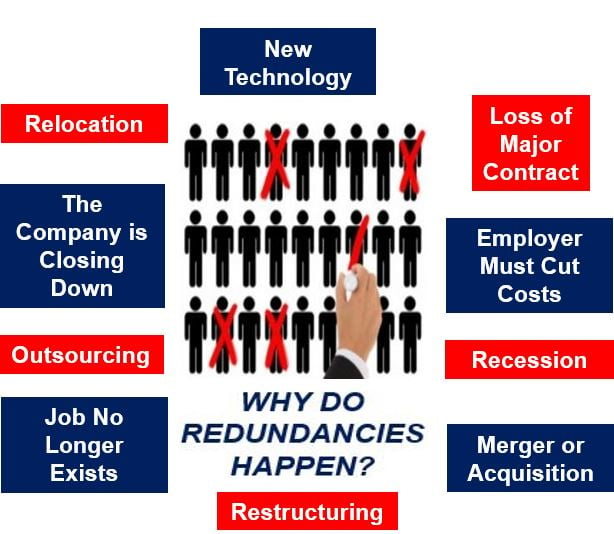Small Business Closing Employee Rights UK: What You Need to Learn About Redundancy
Small Business Closing Employee Rights UK: What You Need to Learn About Redundancy
Blog Article
Exploring the Interplay In Between Business Redundancy and Organizational Versatility for Future Growth
In the vibrant landscape of today's service world, the complex relationship in between company redundancy and business adaptability emerges as an essential variable for continual growth and success. Companies frequently deal with the obstacle of striking a fragile equilibrium in between preserving a degree of redundancy to alleviate threats and cultivating versatility to react swiftly to the ever-evolving market demands. This fragile interaction holds the vital to not just making it through in rough times but additionally flourishing in the face of unpredictability. As we discover the complex measurements of this interplay, appealing understandings into exactly how companies browse these complexities to pave the way for future development wait for.
Importance of Company Redundancy
Company redundancy is an essential aspect that enhances organizational resilience and mitigates functional threats. By including redundancy actions within the business structure, business can better endure unanticipated disturbances and variations in business setting. Redundancy functions as a calculated buffer, allowing companies to adjust and react properly to unanticipated difficulties without jeopardizing vital operations.
One trick facet of the value of company redundancy is its role in ensuring connection during times of crisis. When encountered with unexpected modifications or emergencies, repetitive systems, resources, or workers can action in to keep vital functions and prevent prevalent disruptions. This connection not only safeguards the company's online reputation and client count on yet likewise decreases monetary losses and functional downtime.

Strategies for Organizational Versatility

One more critical strategy is purchasing innovation and facilities that can support adaptability and scalability. Applying electronic devices, automation, and information analytics can streamline operations, improve efficiency, and offer important insights for notified decision-making. In addition, developing versatile business frameworks that enable fast modifications to market characteristics and client requirements is vital for remaining competitive in a quickly progressing atmosphere. By proactively determining prospective interruptions and opportunities, organizations can proactively adjust and grow in an ever-changing company landscape.
Balancing Redundancy and Flexibility
Accomplishing a harmonious stability between functional redundancy and organizational flexibility is vital in navigating the intricacies of a dynamic business setting. Redundancy within a company gives a security net, ensuring connection and stability in procedures. However, an unwanted of redundancy can lead to inefficiencies and hinder adaptability to altering market problems. On the other hand, business adaptability permits firms to react without delay to outside disruptions and confiscate new chances. Striking the right balance in between redundancy and adaptability is a delicate procedure that requires a deep understanding of the organization's objectives, industry dynamics, and threat tolerance.
To attain this equilibrium, firms require to carry out routine evaluations of their procedures to determine areas where redundancy is needed for danger mitigation and where adaptability can drive development and growth. Executing flexible structures, promoting a culture of continuous learning and improvement, and urging open interaction throughout all levels of the organization are vital approaches to integrate redundancy and versatility successfully. By lining up these two crucial elements, firms can place themselves for sustainable growth and success in an ever-changing organization landscape.
Instance Research Studies on Adaptation Success
In analyzing instances of effective business adaptation, it comes to be obvious that the interplay in between functional redundancy and adaptability is a specifying consider forming resilient companies. One compelling instance research study is that of Netflix. Initially a DVD rental solution, Netflix demonstrated remarkable flexibility by transitioning into a streaming system when digitalization interfered with the industry. By tactically investing in technology and web content production, Netflix not just prospered but endured in a quickly advancing market. An additional standout example is Amazon. Starting as an on-line bookstore, Amazon continuously adapted its organization model, broadening right into diverse fields such as cloud computer and expert system. This adaptability allowed Amazon to remain in More Bonuses advance of competitors and satisfy transforming consumer needs. Last but not least, Adobe offers a significant picture of effective adjustment. The company moved from marketing software application licenses to a subscription-based version, ensuring repeating earnings streams and enhanced customer interaction. These instance studies highlight the value of operational visit here redundancy coupled with organizational versatility in cultivating lasting growth and competitiveness.
Building Resilience for Future Development
Structure durability for future growth calls for a tactical alignment of functional processes with market characteristics and emerging patterns. Companies need to adapt to altering environments by cultivating a culture of adaptability, development, and continual enhancement.
In addition, promoting solid connections with stakeholders, such as consumers, employees, vendors, and the community, is crucial for weathering unpredictabilities and keeping trust fund and assistance throughout turbulent times. Efficient interaction and openness play an important duty in building resilience, as they assist promote and align expectations partnership in browsing unpredictabilities.
Additionally, organizations require to focus on knowing and growth campaigns to upskill employees and furnish them with the needed devices to adjust to changing circumstances. By investing in their labor force, companies can improve their versatility and dexterity, inevitably strengthening their durability for sustainable future growth.
Final Thought

In the vibrant landscape of today's business world, the complex connection between company redundancy and organizational flexibility emerges as a vital factor for sustained development and her comment is here success. Companies typically encounter the challenge of striking a delicate equilibrium in between maintaining a level of redundancy to alleviate threats and fostering versatility to react promptly to the ever-evolving market demands.To achieve this balance, business require to perform regular assessments of their operations to recognize locations where redundancy is required for danger reduction and where flexibility can drive technology and growth.In conclusion, the interplay between business redundancy and organizational versatility is critical for future development. Structure strength via a combination of redundancy and adaptability will guarantee that business are prepared for the difficulties of the future.
Report this page